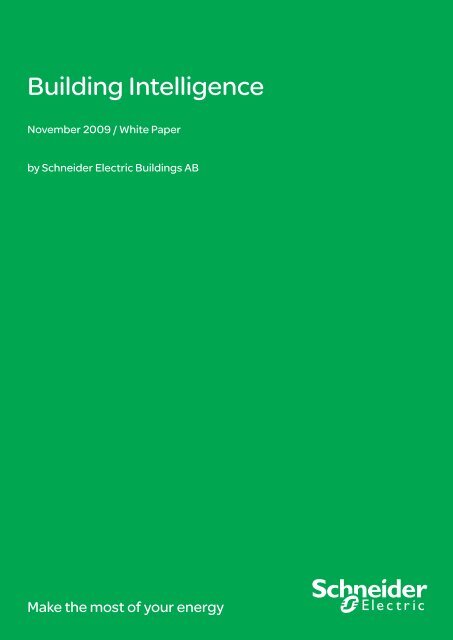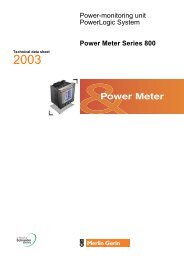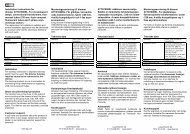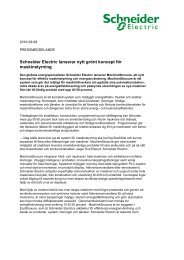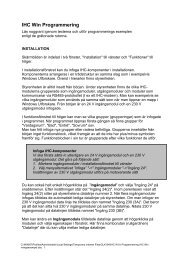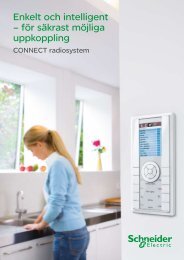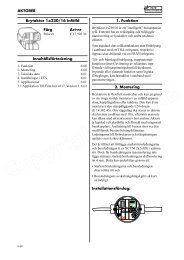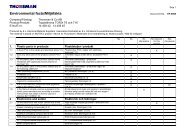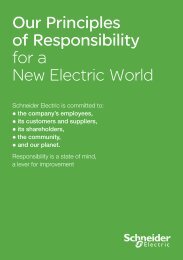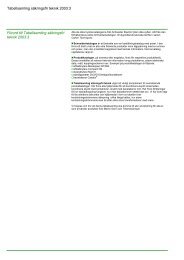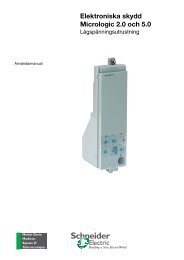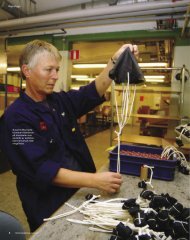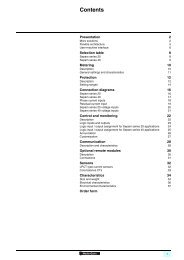Building Intelligence - Schneider Electric
Building Intelligence - Schneider Electric
Building Intelligence - Schneider Electric
You also want an ePaper? Increase the reach of your titles
YUMPU automatically turns print PDFs into web optimized ePapers that Google loves.
<strong>Building</strong> <strong>Intelligence</strong><br />
November 2009 / White Paper<br />
by <strong>Schneider</strong> <strong>Electric</strong> <strong>Building</strong>s AB<br />
Make the most of your energy
Summary<br />
Executive summary..................................................................................... 2<br />
Improving education through the educational environment ........................ 3<br />
Where the opportunities lie ......................................................................... 5<br />
Health ......................................................................................................... 5<br />
Energy savings ........................................................................................... 6<br />
Pedagogical results..................................................................................... 6<br />
Environmental impact ................................................................................. 7<br />
Security....................................................................................................... 7<br />
Conclusion ................................................................................................. 8<br />
School architecture ..................................................................................... 8
<strong>Building</strong> <strong>Intelligence</strong><br />
Executive summary<br />
Our educational infrastructure was to a large extent built in the early<br />
decades of the 20th century or in the era following World War II, and it is<br />
not well adapted to the requirements of modern schooling. Refurbishing<br />
these environments brings a wide range of benefits, including the reduced<br />
absence of teachers and pupils for health reasons, substantial savings in<br />
energy costs and an improved environmental profile. Above all, modern,<br />
dynamic control of the indoor environment and better school security have<br />
been shown to improve academic results in terms of both knowledge<br />
retention and work effectiveness.<br />
White paper on improving educational environments | 2
<strong>Building</strong> <strong>Intelligence</strong><br />
Improving education through<br />
the educational environment<br />
When 16-year-old Susan rides off to school in the morning for a day of<br />
history, mathematics and English classes, what she actually learns will be<br />
defined by a wide range of variables. Her own motivation and abilities,<br />
her teachers’ and her school’s methodologies and the other educational<br />
resources she can draw on (family, libraries, etc.) are all important factors in<br />
the pedagogical mix. In addition, modern research points to another factor<br />
that steers her intellectual development: the school’s physical environment.<br />
Over the centuries, teaching environments and school buildings have varied<br />
greatly – from one point in time to another, from one culture to another, from<br />
one political system to another. From Plato’s Akademia outside Athens to<br />
today’s advanced learning establishments, school buildings as such have<br />
evolved to be better adapted to the needs of the modern curriculum.<br />
Many of our schools had their cornerstones laid in the late 19th or early 20th<br />
centuries, or they stem from the baby boom years that followed World War<br />
II. Clearly, these buildings were constructed according to other standards<br />
than those that govern the modern educational system. And as concerns<br />
mount over the inadequacies of the school environment, politicians and<br />
school authorities are increasing their efforts to modernise school buildings.<br />
Initiatives such as “Schools of the Future” in the UK and various programmes<br />
within the EU and US are examples of such political drives.<br />
Currently, as part of the vast stimulus packages presented by governments<br />
worldwide to counter the recessional effects of the 2008 financial crisis,<br />
funds are being made more readily available for such initiatives and such<br />
investments. The OECD recently stated that: 1<br />
– Countries are using public sector building and civil engineering<br />
construction, including education buildings, as one of the means to<br />
stimulate their economies.<br />
– Education clearly benefits, and the crisis is providing an<br />
opportunity for governments and education authorities to address<br />
such issues as modernisation, earthquake-proofing and the<br />
environmental performance of buildings.<br />
In the US, the American Recovery and Reinvestment Act of 2009 (ARRA)<br />
states that funds may be used “for modernization, renovation, or repair of<br />
public school facilities and institutions of higher education facilities.”<br />
With both the will to improve the educational environment and the increasing<br />
availability of funds in place, it is important to look at which are the key<br />
issues, where the most effective improvements lie and what tools and<br />
systems are available to bring about change.<br />
1<br />
OECD/CELE 2009<br />
White paper on improving educational environments | 3
<strong>Building</strong> <strong>Intelligence</strong><br />
for Education Segment
<strong>Building</strong> <strong>Intelligence</strong><br />
Where the opportunities lie<br />
Many of the programmes for the improvement of While there are many factors that come into<br />
education buildings focus on a number of key play in assuring a healthy school environment,<br />
issues. These include:<br />
indoor air quality (IAQ) is therefore a key<br />
component. Poor IAQ is a known contributor<br />
• Health<br />
to a number of significant health problems. I<br />
addition to increasing the rate of transmission for<br />
• Energy savings<br />
infectious diseases such as colds, influenza and<br />
• Pedagogical results<br />
tuberculosis, it has a role in asthma, which affects<br />
• Environmental impact<br />
more than 5% - 10% of the school population. 2<br />
• Security<br />
The management of indoor air quality can<br />
significantly reduce the health hazards created<br />
Health<br />
by inadequate HVAC function. Improved airflow<br />
Health is of course a basic concern when<br />
control can be provided without energy penalties,<br />
creating an educational environment. Millions<br />
simply by gaining more precise control over<br />
of students and teachers spend a significant<br />
ventilation rates. A dynamic, continuously<br />
portion of their days in public and private school<br />
adjusting system will provide the greatest health<br />
buildings. Many of these buildings are old and in<br />
benefits and flexibility.<br />
poor condition, and they may have environmental<br />
characteristics that inhibit learning and pose<br />
increased risks to the health of children and staff.<br />
School buildings are prone to a variety of<br />
indoor environmental problems that may result<br />
in symptoms of illness among teachers, staff<br />
and students. In addition to having very high<br />
occupant densities, they are in many instances<br />
poorly maintained. The three major risk factors<br />
for school-building-related health complaints are<br />
inadequate ventilation, surface dust / inadequate<br />
cleaning and mould. 2<br />
2 White paper on improving educational environments | 5<br />
www.automatedbuildings.com
<strong>Building</strong> <strong>Intelligence</strong><br />
Energy Savings<br />
One aspect of improving schools and the<br />
management of heating/AC and ventilation, for<br />
example by preventing an increase in heating<br />
when a window is opened.<br />
performance of students is the amount of<br />
resources channelled into the teaching itself<br />
Intelligent control of the energy consumption in<br />
as opposed to other support functions. The<br />
schools has been shown to provide substantial<br />
potential for energy savings in schools creates<br />
savings in energy costs. Studies exhibit varying<br />
an important opportunity to reallocate funds<br />
results depending on the site, but savings in the<br />
to the teaching staff and to other more active<br />
range of 15% – 30% are common. According<br />
teaching resources.<br />
to the Sustainable <strong>Building</strong>s Industry Council,<br />
school districts can save 30% – 40% on utility<br />
Many schools were built in an era of cheap<br />
costs each year for new schools and 20% –<br />
energy, when concern over energy costs was not<br />
30% for renovated schools, simply by applying<br />
among the central design criteria. As a result,<br />
sustainable, high-performance, energy-efficient<br />
these schools today are often energy inefficient.<br />
design and construction concepts that improve<br />
This inefficiency is due in some part to structural<br />
classroom comfort. 3<br />
issues (building construction), but a greater<br />
portion can be attributed to the inefficient control<br />
As one example, Strandskolan elementary school<br />
of energy usage. Areas of energy use in schools<br />
in Malmö, Sweden lowered its consumption<br />
today include:<br />
to 55 kWh by installing an integrated building<br />
management system. The average for schools<br />
• Lighting<br />
in the city is 120 kWh, and the difference<br />
• Fans, pumps and controls<br />
translates into savings that can be redirected into<br />
• Cooling<br />
Strandskolan’s teaching resources.<br />
• Heating<br />
• Hot water<br />
Pedagogical Results<br />
Not only does improved HVAC and energy<br />
The use of school premises is highly irregular,<br />
management in schools safeguard health<br />
both in terms of the school year and in terms of<br />
and save on costs, research shows that an<br />
the school day. Some classrooms may be used<br />
improved indoor environment also leads to<br />
intensively, whereas others may be used more<br />
a clear improvement in pedagogical results.<br />
sporadically. The fl ow of students and teaching<br />
A recent study published by the Technical<br />
staff through the premises puts irregular demands<br />
University of Denmark 4 shows a correlation<br />
on a school’s HVAC systems. Traditionally these<br />
between variations in airflow and temperature<br />
have been met by maintaining a static level of<br />
control and a student’s academic performance.<br />
heating, AC and ventilation over time. However,<br />
In experiments conducted both summer and<br />
modern systems with integrated control solutions<br />
winter at an elementary school in Denmark,<br />
permit highly dynamic control of the indoor<br />
pupils were given normal schoolwork in<br />
climate, in which the levels are tuned to coincide<br />
mathematics and language training (reading<br />
with actual room usage. Even a room’s lighting<br />
and comprehension). Clear improvements in<br />
can be steered according to its occupancy, and<br />
pupil performance were registered, with top<br />
sensor control can be used to synchronise the<br />
levels showing a 35% improvement and average<br />
levels a 15% improvement.<br />
3 www.greenbuildingnews.com<br />
White paper on improving educational environments | 6<br />
4 indoor environment and learning in schools. DTU 2009
<strong>Building</strong> <strong>Intelligence</strong><br />
Other studies confirm these results. The University building management system helps to achieve<br />
of Reading has measured work rate improvements the environmental objectives through intelligent<br />
of 7% in addition and subtraction with an improved resource management such as dynamic control<br />
indoor environment. In a Milwaukee research of lighting, heating and ventilation. The reduced<br />
programme, Myhrvold et al reports a significant energy consumption attained by such means can<br />
relationship between a facility’s condition and considerably diminish the environmental footprint<br />
student achievement in mathematics, science, of any educational institution.<br />
language and social studies. 5<br />
Security<br />
The clear relationship between student performance<br />
Naturally, academic performance also depends<br />
and an improved indoor environment is an important<br />
on a student’s ability to focus on his or her<br />
incentive for reviewing the current indoor environment<br />
studies. Disruptions, and even worse a feeling<br />
in schools in order to support better learning.<br />
of insecurity, distract from the most wellintended<br />
pedagogy. In a study commissioned by<br />
Learning, after all, is what school is all about.<br />
<strong>Schneider</strong> <strong>Electric</strong>, a large number of teachers<br />
Environmental impact in the UK responded to questions about security<br />
Environmental concerns form much of today’s issues in their schools. Of these, 51% stated that<br />
political agenda, with municipalities around the levels of indiscipline and crime in schools<br />
the world setting objectives for environmental interfered with pupils’ ability to learn. Another<br />
protection. Reduction objectives for carbon 33% said that it sometimes did.<br />
emissions have been defined by most<br />
governments and municipalities, with aggressive Creating a tranquil, calm and secure environment<br />
objectives in the 2015 – 2020 horizon. The city in schools is an important and perpetual issue,<br />
of Paris has set the ambitious objectives of and most of the answer lies in people and<br />
reducing greenhouse gas emissions over 2004 processes such as anti-bullying initiatives.<br />
levels by 30% as of 2020 and 75% as of 2050. But technology can also lend a helping hand,<br />
Frankfurt am Main has special programmes especially when it comes to criminality and the<br />
for CO2 reduction in schools, which achieved damage or destruction of property. Access<br />
reductions of up to 10,000 tons between 1997 control and surveillance systems can both<br />
and 2007 and which are still ongoing.<br />
monitor and deter. And entrance systems can<br />
log a pupil’s presence in the school, a feature<br />
<strong>Building</strong> energy often represents a large part of appreciated by parents for the feeling of safety<br />
the overall energy consumption: values between and security it provides.<br />
25% and 40% 6 of all energy are calculated for the<br />
building sector within the OECD. And municipal A study 7 among teachers, students and parents<br />
buildings, with many schools among them, are in Sweden showed a high degree of acceptance<br />
thus a prime target for environmental efforts. for such solutions in schools. Of the students and<br />
parents surveyed, 70% or more would accept<br />
Creating a “green” school implies a wide<br />
security solutions in schools (including CCTV)<br />
range of activities, touching on everything<br />
and over 80% said that such systems would<br />
from construction aspects to a well-managed decrease property damage, theft and violence.<br />
recycling programme. Again, an intelligent<br />
5 CEFPI 2000<br />
White paper on improving educational environments | 7<br />
6 Environmentaslly sustainable buildings, OECD 2003<br />
7 SSF 2009 (in Swedish)
<strong>Building</strong> <strong>Intelligence</strong><br />
Conclusion<br />
As we look to the future and the formative years<br />
of coming generations, a holistic approach to the<br />
educational environment must be taken – one that<br />
comprises teaching curricula and pedagogies<br />
but also the learning environment as such. By<br />
building the smarter schools of the future today,<br />
we can profit from short-term gains in cost and<br />
resource allocations while building a wholesome<br />
future for our children in the long term. A future<br />
that stimulates their knowledge and abilities, as<br />
well as one that safeguards their health and the<br />
environment of the world they live in.<br />
School architecture<br />
Interest in and concern for the educational<br />
environment is nothing new. Already in 1809,<br />
Joseph Lancaster published a pioneering work<br />
regarding Hints and Directions for <strong>Building</strong>,<br />
Fitting Up, and Arranging School Rooms. Views<br />
on how best to build the educational institutions<br />
of the 19th and 20th centuries varied with<br />
the times, with the school buildings reflecting<br />
the thoughts and views of each period. The<br />
19th century saw the emergence of public<br />
schooling, with the increased focus on broad<br />
education that came with increasing wealth and<br />
democratisation. As public schooling grew in<br />
scope, the need for appropriate educational<br />
facilities arose. Whereas the school buildings of<br />
the early 19th century were ad hoc solutions –<br />
often comprising existing facilities in churches<br />
or public buildings, teachers’ homes or simple<br />
wooden buildings with a single classroom,<br />
those of the second part of the century followed<br />
trends of increased standardisation, as well as<br />
increasing focus on the school as a symbol of<br />
the new society. European laws defined in the<br />
period 1860 – 1880 regulated school space and<br />
hygiene requirements, while school architecture,<br />
especially in urban areas, became more<br />
elaborate or at times even monumental.<br />
Some late examples of such schools include am<br />
Elizabethplatz in Munich (Theodor Fischer, 1900–<br />
1901), the school on the rue Rouelle in Paris<br />
(Louis Bonnier, 1908–1911) and Letten in Zurich<br />
(Adolf and Heinrich Bram, 1912–1915).<br />
In the 20th century, growing concern over<br />
health and hygiene (stemming from the rise of<br />
tuberculosis) redefined the requirements placed<br />
on schools. This was also the age of le Corbusier,<br />
who called for “a new spirit”, a house “like a<br />
receptacle for light and sun.” Larger windows,<br />
improved ventilation and recreational areas<br />
became the defining guidelines.<br />
The New Education movement let the<br />
pedagogical requirements define the school<br />
environment: the development of group activities<br />
and the improvement of the students’ sense<br />
of initiative and autonomy required more open<br />
and flexible school buildings. Pavilion schools,<br />
one-story schools for easy outdoor access, were<br />
examples of the era.<br />
After World War II, the baby boom of the late<br />
1940s put new demands on capacity. Many of<br />
our schools today date back to this period and<br />
require adaptation to meet today’s demands<br />
on school architecture, such as flexibility in<br />
floor plans and the ability to function as multipurpose<br />
buildings (community centres). Not<br />
least, lighting and ventilation continue to be<br />
focal points for creating effective and safe<br />
educational environments.<br />
White paper on improving educational environments | 8
<strong>Schneider</strong> <strong>Electric</strong><br />
Jägershillgatan 18<br />
213 75 Malmö, Sweden<br />
Phone: + 46 (0) 40 38 68 50<br />
www.schneider-electric.com/buildings<br />
WP_EDU_BLDINT_A4.UK.EN.12.2009.0.00.CC<br />
All brand names, trademarks and registered trademarks are<br />
the property of their respective owners. Information contained<br />
within this document is subject to change without notice.<br />
December 2009 pdw<br />
© 2009 <strong>Schneider</strong> <strong>Electric</strong>. All rights reserved.


